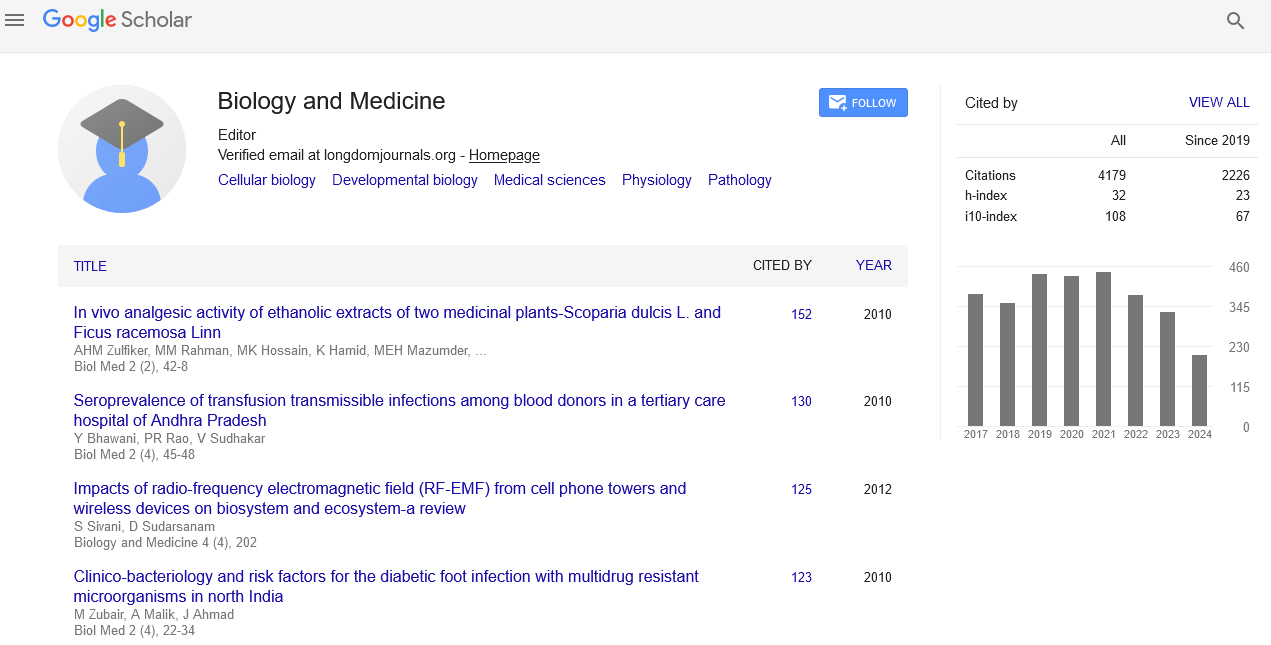Indexed In
- Open J Gate
- Genamics JournalSeek
- CiteFactor
- Cosmos IF
- Scimago
- Ulrich's Periodicals Directory
- Electronic Journals Library
- RefSeek
- Hamdard University
- EBSCO A-Z
- Directory of Abstract Indexing for Journals
- OCLC- WorldCat
- Proquest Summons
- Scholarsteer
- ROAD
- Virtual Library of Biology (vifabio)
- Publons
- Geneva Foundation for Medical Education and Research
- Google Scholar
Useful Links
Share This Page
Journal Flyer

Open Access Journals
- Agri and Aquaculture
- Biochemistry
- Bioinformatics & Systems Biology
- Business & Management
- Chemistry
- Clinical Sciences
- Engineering
- Food & Nutrition
- General Science
- Genetics & Molecular Biology
- Immunology & Microbiology
- Medical Sciences
- Neuroscience & Psychology
- Nursing & Health Care
- Pharmaceutical Sciences
Commentary - (2023) Volume 15, Issue 12
Overview on Nephrogenesis from Development of Kidney to its Disorders
Karen Tew*Received: 22-Nov-2023, Manuscript No. BLM-23-24524; Editor assigned: 24-Nov-2023, Pre QC No. BLM-23-24524(PQ); Reviewed: 07-Dec-2023, QC No. BLM-23-24524; Revised: 14-Dec-2023, Manuscript No. BLM-23-24524(R); Published: 21-Dec-2023, DOI: 10.35248/0974-8369.23.15.636
Description
Kidney development, known as nephrogenesis is a process that begins early in embryonic life and continues through fetal development. This intricate process involves the formation of functional units called nephrons, which are essential for kidney function. The stages of nephrogenesis, highlights the molecular mechanisms that govern nephron formation and emphasizing their important role. These tiny structures play functional in maintaining homeostasis within the human body. The kidneys are vital organs in the human body, are responsible for filtering waste products and regulating fluid balance. Understanding the developmental processes that give rise to these complex structures is of paramount importance. Nephrogenesis, the formation of nephrons, represents a pivotal phase in kidney development and holds the key to unraveling kidney-related disorders and potential regenerative therapies.
Nephrogenesis initiates in the nephrogenic zone, a region in the fetal kidney where mesenchymal cells undergo a transformation into epithelial structures. This process, known as Mesenchymalto- Epithelial Transition (MET), is processed by various growth factors, including Fibroblast Growth Factors (FGFs) and Wingless/Int (Wnt) signaling molecules. MET triggers the formation of renal vesicles, the earliest discernible structures in nephron development. Renal vesicles undergo complex morphological changes, giving rise to comma-shaped and Sshaped bodies. These structures, guided by intricate interplays of signaling pathways eventually develop into mature nephrons. The ureteric bud, an outgrowth from the developing ureter, plays an important role in inducing nephrogenesis. Reciprocal interactions between the ureteric bud and the metanephric mesenchyme are fundamental in determining the final number and complexity of nephrons.
One of the primary segments of the nephron is the renal corpuscle, consisting of the Bowman's capsule and the glomerulus. The Bowman's capsule encapsulates the glomerulus, a tuft of capillaries where blood filtration occurs. The initial stage of nephron segmentation involves the formation of these structures, setting the foundation for subsequent functional differentiation. As the nephron matures, it undergoes further segmentation into the Proximal Convoluted Tubule (PCT), loop of Henle, Distal Convoluted Tubule (DCT), and connecting tubule. Each segment has specialized functions crucial for renal physiology. The PCT, for instance, is responsible for reabsorbing the majority of filtered substances, such as glucose, amino acids, and electrolytes. This process ensures that essential substances are retained in the body, contributing to overall homeostasis.
The loop of Henle, extending into the medulla of the kidney, plays a key role in establishing an osmotic gradient essential for concentrating urine. The intricate countercurrent multiplication mechanism within the loop allows for efficient water reabsorption, a critical adaptation for maintaining body fluid balance. Moving along the nephron, the DCT and connecting tubule are involved in fine-tuning the composition of urine. Hormonal regulation, particularly by aldosterone and Antidiuretic Hormone (ADH), influences the reabsorption of water and electrolytes in these segments, contributing to the final composition of urine excreted from the body. Functional differentiation within the nephron is not limited to its structural segments. Specialized cells within each segment express specific transporters, channels, and receptors that contribute to the selective reabsorption and secretion of substances. For instance, the PCT is equipped with numerous microvilli and mitochondria to facilitate the efficient reabsorption of substances, while the DCT contains cells responsive to parathyroid hormone, regulating calcium and phosphate balance.
Disruptions in nephron segmentation and functional differentiation can lead to various renal disorders. Congenital anomalies, genetic mutations, or environmental factors may interfere with the normal development of nephrons, impacting their structure and function. Conditions such as polycystic kidney disease, renal tubular acidosis, or nephrotic syndrome underscore the critical importance of proper nephron development for maintaining renal health. Disruptions in these delicate molecular processes can lead to congenital kidney disorders and contribute to the understanding of kidney diseases in adults.
Citation: Tew K (2023) Overview on Nephrogenesis from Development of Kidney to its Disorders. Bio Med. 15:636.
Copyright: © 2023 Tew K. This is an open-access article distributed under the terms of the Creative Commons Attribution License, which permits unrestricted use, distribution, and reproduction in any medium, provided the original author and source are credited.


